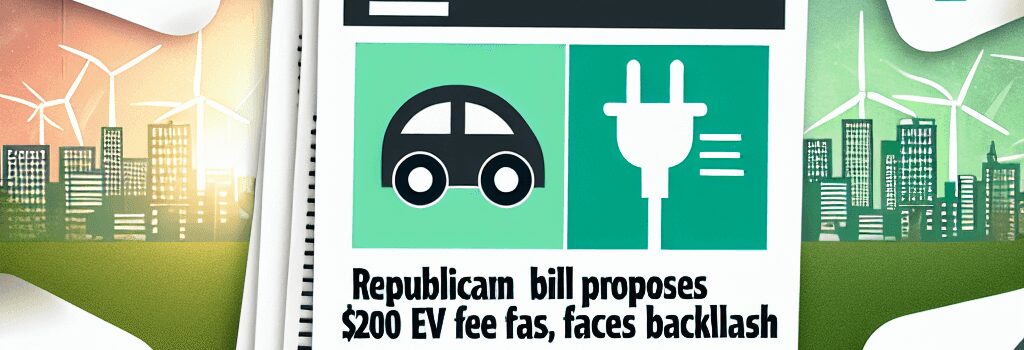Republican Bill Proposes $200 EV Fees, Faces Backlash

Overview of Proposed Fees
On April 30, 2025, the House Transportation and Infrastructure Committee unveiled a new budget reconciliation bill that would impose annual registration fees far higher on battery-electric and hybrid vehicles than on conventional internal-combustion models. Under Chair Sam Graves’s (R-Mo.) plan:
- Battery-electric vehicles (BEVs) would pay a $200 federal registration fee each year.
- Hybrid electric vehicles (HEVs and fuel cell EVs) would pay $100 annually.
- Internal-combustion engine (ICE) passenger cars—including heavy pickups such as the Ford F-350 with a Duramax diesel—would pay just $20 per year, starting October 1, 2030 (zero through 2029).
All fees are indexed to the Consumer Price Index (CPI) and would rise annually until their sunset dates: 2034 for pure-ICE vehicles and 2035 for EVs and hybrids. State Departments of Motor Vehicles (DMVs) would collect the fees on behalf of the federal government; noncompliance would trigger a 125 percent withholding of federal highway funds under 23 U.S.C. § 158.
Technical and Economic Implications
Electric vehicles today enjoy a roughly 15–20 percent total cost of ownership (TCO) advantage over comparable ICE models, driven by lower energy and maintenance costs. A $200 annual fee adds about $0.03–$0.05 per mile to typical EV TCO—eroding the payback period on higher battery-pack costs.
For a midsize EV with a 60 kWh battery, the extra fee raises the levelized cost of charging (at 13 cents/kWh) by about 2 percent and reduces net present value (NPV) savings compared to a gasoline sedan by up to $1,200 over eight years. National Renewable Energy Laboratory (NREL) models show that a 10 percent increase in ownership costs can suppress EV adoption rates by 4–6 percent.
Impact on EV Adoption and Infrastructure
According to a recent study by the International Council on Clean Transportation (ICCT), U.S. EV market share could stagnate at 12 percent without additional incentives. The proposed fees risk pushing back fleet electrification targets in the Inflation Reduction Act (IRA) and the Bipartisan Infrastructure Law (BIL), which aim for 50 percent new EV sales by 2030.
The higher costs may also slow private and public charging deployments. Utilities and charging-network operators price projects based on forecasted throughput; reduced EV growth increases levelized cost of electricity (LCOE) for charging stations, potentially deterring Rural Energy for America Program (REAP) and National Electric Vehicle Infrastructure (NEVI) grant recipients from building out fast-charging corridors.
State Compliance and Federal Enforcement
The federal government cannot directly mandate state registration fees, but it can leverage 23 U.S.C. § 158—used previously for the National Minimum Drinking Age Act—to coerce compliance. Any state declining to collect the federal EV and hybrid fees would lose 125 percent of its annual surface transportation apportionments, effectively compelling uniform implementation across all 50 states.
Budgetary Impact and the Highway Trust Fund
Proponents argue the fees will shore up the Highway Trust Fund, which relies predominantly on a stagnant 18.4 cents-per-gallon federal gasoline tax. The Eno Center for Transportation projects an additional $110 billion pumped into the Trust Fund by 2035. Yet even with these new receipts, the fund would still face a projected $222 billion shortfall, as CBO baseline forecasts anticipate rising maintenance costs and aging infrastructure demands.
Expert Opinions and Analysis
- Katherine Garcia, Sierra Club: “Penalizing EV drivers undermines climate goals and public health benefits. We need to incentivize zero-emission vehicles, not impose regressive fees that disproportionately affect middle-income families.”
- Dr. Anita Sengupta, Caltech Media Lab: “From an energy-systems perspective, discouraging electrification increases carbon-intensity per mile. Every 1 percent drop in EV adoption can add roughly 7 million metric tons of CO₂ emissions annually in the U.S.”
- Mark Cooper, Consumer Watchdog: “This legislation shifts highway funding onto the backs of clean-technology adopters while granting a decades-long subsidy to the largest-polluting vehicles.”
Additional Considerations: Emissions and Climate Goals
DOE’s GREET lifecycle analysis estimates a mid-size BEV charged on the U.S. grid emits 150 g-CO₂e per mile, compared to 400 g-CO₂e/mile for a typical ICE sedan. The proposed fees threaten the Biden administration’s pledge to cut U.S. transport emissions 50 percent by 2030 under the Paris Agreement, especially if states slow down EV rebate and HOV-lane waiver programs.
Potential Industry and Market Responses
Automakers may absorb or partially offset the fees through purchase incentives or extended warranties. Some fleets could reclassify vehicles as commercial to evade the charges, similar to past strategies during the 2002 Section 179 truck tax deduction. Telemetry-based mileage taxes and dynamic road-pricing pilots—already underway in Oregon and Utah—could offer alternative revenue mechanisms that align usage fees with real-world road wear.
Outlook and Next Steps
The bill is expected to pass the House via reconciliation in early May. Senate action is less certain, with moderate Republicans like Susan Collins (R-ME) and Joe Manchin (I-WV) seeking modifications to avoid derailing broader infrastructure priorities. The White House has threatened a veto, calling the proposal “an attack on clean energy and working families.” Stakeholders are mobilizing comment letters ahead of the Senate Finance and Environment and Public Works Committee hearings scheduled for June 2025.